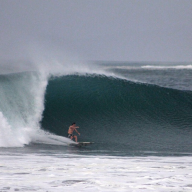Statistics That Fool Investors
I’ve got a problem with traveling to “dangerous” countries.
Like an addiction problem, where I feel the need to visit dangerous places to look for opportunity.
I put “dangerous” in quotations not because I think these places are dangerous, but because that’s what most people think.
They think that when you get off the plane in some exotic destination, there’s a guy waiting for you in the terminal with a sword ready to chop off your head.
That’s what a lot of people think. And that’s why there is so much unexplored opportunity out there.
It’s the fear of the unknown. The fear of that guy in the airport that’s going to take your head and eat it for dinner. That’s what people do in dangerous countries – they eat people’s heads. Right?
I’m actually fine with that perception. More good stuff out there for me!
But, the reality is that our world is becoming much more connected.
Air travel is cheaper than ever, statistically the world is safer than ever, and the internet has allowed all kinds of information to flow freely.
This trend is only set to accelerate, allowing people to travel the world inexpensively and safely.
Additionally, investors worldwide are starting to notice the opportunities that are beyond their borders.
Even major institutions likes Credit Suisse see the opportunity, and that’s why they are bullish on emerging markets in 2017.
“Broad emerging markets in Asia and Latin America are at an advantage due to a huge domestic consumer base, while China and India are rising at twice the pace of global growth.”
This domestic consumer base is what many ‘first world investors’ don’t understand. It’s a bias that is held by those fearful to go outside their comfort zone.
In fact, there is an actual term for this. It’s called “home country bias.”
This bias leads to the assumption that anything outside of an investor’s knowledge is dangerous.
However, my friend Kim Iskyan, thinks that this strategy – of only investing in your home country – is like juggling dynamite.
“Due to ‘home country bias,’ the average American with a stock portfolio has 79 percent of her money in U.S.-listed stocks. Investors in Japan put about 55 percent of their money in Japan-listed stocks. People in Australia have two-thirds of their portfolio in local shares.”
The easiest solution that Kim suggests (and I agree with) is to simply buy an ETF of a country you’d like to diversify into. For example, if you wanted to invest in Italy, you’d just buy the iShares MSCI Italy Capped ETF, with the ticker $EWI. Japan would be $EWJ. Brazil would be $EWZ. And there are dozens more.
Now, that’s the easiest way to diversify. But it’s not necessarily the best way.
The best way is to physically travel to where you want to invest. You get a real sense of where you’ll be putting your money. You find out that either it’s a great investment, or a horrible one.
But… what about the danger part? The guy who’s going to chop off your head?
I just bought an apartment in the “10th most dangerous city in the world,” but I’ve never had a problem there.
On that same list, there are many US cities that are considered as the most dangerous in the world.
I actually have a lot of friends who happily live in the 19th most dangerous city – Baltimore.
My point here is not to pursue danger. I’m just highlighting the statistics that fool investors. The fear of the unknown is what keeps most people away from these outside locations.
But, this fear is what creates an advantage for those who are willing to see things for what they actually are.
Of course if you go to one of these dangerous cities and look for trouble then you’ll certainly find it. There are many parts of Los Angeles (near where I’m located) that I wouldn’t venture into.
Now, if we look for opportunity (instead of danger), then we’ll find that too.




